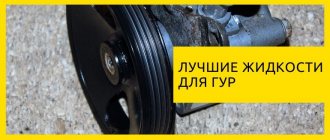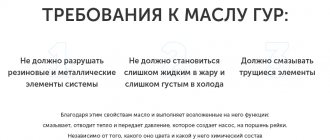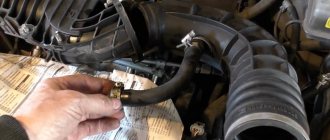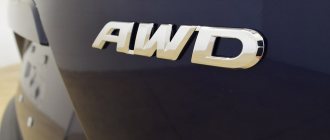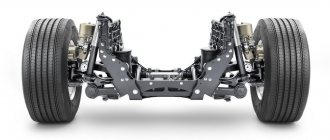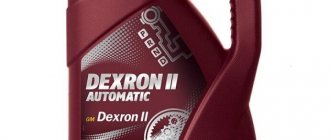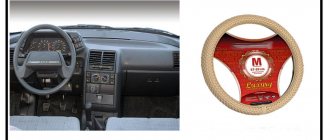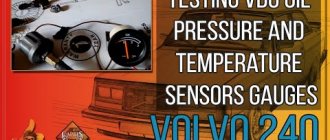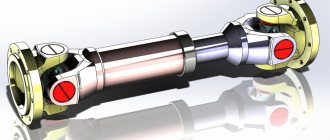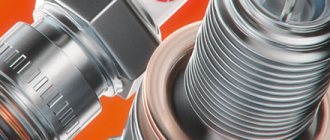ATF Dexron service fluid (Dexron) is a widespread product in the markets of different countries and is actively used by owners of various brands and models of cars. This fluid, which is often also called Dextron or Dextron (and in everyday life these not entirely correct names are used very widely), is the working fluid in automatic transmissions, power steering and other mechanisms and assemblies.
In this article we will look at what Dexron ATF is, where and when it was developed. Also, special attention will be paid to what types of this fluid exist and how the different types differ, which Dextron to pour into automatic transmissions and other units, etc.
Types and types of Dexron liquids
Let's start with the fact that today you can find fluids ranging from Dexron 2, Dexron IID or Dexron 3 to Dexron 6. In fact, each type is a separate generation of transmission fluid, widely known as Dexron. The development belongs to the concern General Motors (GM), which in 1968 created its own transmission fluid for automatic transmissions, Dexron.
Let us note that in those years the auto industry was at a stage of active development, large automakers everywhere developed tolerances and standards for oils and transmission fluids. Subsequently, these tolerances and specifications became a mandatory requirement for third-party companies producing technical fluids for cars.
- Let's return to Dextron. After the first generation of such fluids entered the market, just 4 years later GM was forced to develop the second generation of Dextron.
The reason is that the first generation actively used whale oil as a friction modifier, and the transmission oil itself on this basis quickly became unusable due to high heat in the automatic transmission. A new formula was supposed to solve the problems, which became the basis of Dexron IIC.
In fact, whale oil was replaced with jojoba oil as a friction modifier, and the product's heat resistance was also improved. However, with all the advantages, the composition had one serious drawback - severe corrosion of automatic transmission elements.
For this reason, corrosion inhibitors began to be added to the transmission fluid to avoid the active appearance of rust. The result of such improvements was the appearance in 1975 of the Dexron IID product. Further, during operation, it turned out that the transmission fluid, due to the addition of an anti-corrosion package, tends to accumulate moisture (hygroscopicity), which led to a rapid loss of properties.
For this reason, they quickly stopped using Dexron IID, releasing the product Dexron IIE, filled with active additives that work against moisture and corrosion. It is noteworthy that this generation of liquid has become semi-synthetic.
Moreover, having convinced itself of its effectiveness, after a short period of time the concern released a fundamentally new liquid with improved performance characteristics. First of all, while earlier generations were mineral or semi-synthetic based, the new Dexron 3 ATF was made from a synthetic base.
This solution turned out to be resistant to high heat, had excellent lubricating and protective properties, and remained fluid at low temperatures (up to -30 degrees Celsius). It was the third generation that became truly universal and began to be widely used in automatic transmissions, power steering, etc.
- Today, the latest generation is Dexron VI (Dextron 6), developed for the six-speed Hydra-Matic 6L80 automatic transmission. The product has improved lubricating properties, reduced kinematic viscosity, resistance to foaming and corrosion.
Moreover, the manufacturer positions such a liquid as a composition that does not require replacement. In other words, such oil is poured into the automatic transmission for the entire service life of the unit.
Of course, in reality, the oil in the box needs to be changed every 50-60 thousand kilometers, but it is obvious that the properties of Dextron 6 are noticeably improved. As practice shows, Dextron VI also loses its properties over time, but it needs to be changed less often than the outdated Dextron III.
- Please note that different manufacturers began to produce automatic transmission fluids quite a long time ago, and the products are produced under the Dexron brand. As for GM, the concern has been producing only this type of fluid since 2006, while other oil manufacturers continue to produce Dextron IID, IIE, III, etc.
As for GM, the corporation is not responsible in any way for the quality and properties of fluids of previous generations, although they continue to be produced according to the Dexron standard. It can also be noted that today Dexron fluids can be standard or HP (high performance) for automatic transmissions that operate in difficult conditions.
There are also Dexron Gear Oils for differentials and clutches, Dexron Manual Transmission Fluid for manual transmissions, Dexron Dual Clutch Transmission Fluid for dual-clutch robotic gearboxes, Dextron for power steering, as well as other units and mechanisms. There is information that General Motors is testing the latest generation of fluid for use as a transmission oil for CVTs.
Which Dexron to fill and is it possible to mix Dextron
First, it is important to decide what type of oil can and should be poured into the box. You should look for information in the manual; you can also look at what is indicated on the automatic transmission oil dipstick.
If Dexron III is marked on the dipstick, it is better to pour only this type, which guarantees normal operation of the box. If you experiment with switching from the recommended liquid to any other, the result is difficult to predict.
Let's move on. Before using one or another type of ATF Dexron, you need to separately consider the climatic conditions in which the car with automatic transmission will be located. GM recommends using Dextron IID in regions where the temperature does not drop below -15 degrees, Dextron IIE up to -30 degrees, Dextron III and Dextron VI up to -40 degrees Celsius.
Now let's talk about mixing. General Motors itself provides separate recommendations for mixing and interchangeability. First, you can add another oil with technical characteristics to the main volume of transmission fluid only within the limits that are separately determined by the transmission manufacturer.
Next, when mixing, you should be guided by the base base (synthetics, semi-synthetics, mineral oil). In short, in some cases it is still possible to mix mineral oil and semi-synthetics, however, mixing synthetics and mineral oil may cause undesirable reactions.
For example, if you mix mineral Dextron IID with synthetic Dextron IIE, a chemical reaction may occur and substances will precipitate, which can cause automatic transmission breakdowns and loss of properties of the working fluid.
We also recommend reading the article about whether gear oils can be mixed. In this article, you will learn about the features of mixing gearbox oils, as well as what you need to consider if you need to mix oil in a car's gearbox.
At the same time, mineral Dextron IID can be mixed with Dextron III. In this case, there are also risks, but they are somewhat reduced, since the main additives in these liquids are often similar.
If we consider the interchangeability of Dextron, then Dexron IID can be replaced with Dexron IIE in any automatic transmission, but Dextron IIE should not be replaced with Dextron IID.
In turn, Dexron III can be poured into a box where Dexron II liquid was used. In this case, a reverse replacement (rollback from Dextron 3 to Dextron 2) is prohibited. Also, in cases where the unit does not imply the possibility of reducing the friction coefficient, then replacing Dextron II with Dextron III is not allowed.
It is quite obvious that the above information is for informational purposes only. As practice shows, it is optimal to fill the box only with the option recommended by the manufacturer.
It is also allowed to use analogs that are slightly improved in certain properties and indicators. For example, switching from synthetic Dextron IIE to synthetic Dexron III (it is important that the base oil base and the main additive package remain unchanged).
If you make a mistake and fill the automatic transmission with non-recommended transmission fluid, then problems may arise (slipping of the friction discs, viscosity mismatch, loss of pressure, etc.) In some cases, the clutches can quickly wear out, which will require repair of the automatic transmission.
What is the difference between Dextron 2 and 3?
Content
I am very often in the process of working, etc. I am faced with the issue of interchangeability of Dextron II and Dextron III. What is this? Dextron is the brand name for a group of automatic transmission performance products created by General Motors (GM), established in 1968. Dextron=Automatic transmission fluids (ATF).
Automatic gearboxes (hereinafter referred to as automatic transmissions) use a special fluid, which is often called oil - ATF. Historically, the legislator in the field of setting standards in the field of automatic transmission fluids has been General Motors (GM), whose specifications are used by both ATF and automatic transmission manufacturers. So, in the 80s, the current GM specification was Dexron IID, which was then replaced by Dexron IIE, and in 1993 by Dexron III.
The only differences between Dexron IIE and Dexron IID are the low temperature viscosity. That is, at the operating temperature of the automatic transmission, there is practically no difference in the performance properties of IIE and IID. Well, except that IIE has greater stability of properties throughout its entire service life, since it is a completely synthetic fluid, and IID has a mineral base. However, at the very beginning of work, while the box has not yet warmed up, the differences are very significant - the viscosity of Dexron IID at -40°C is 45,000 mPa s, and Dexron IIE at the same temperature is 20,000 mPa s. From this we can see that it is much easier for the engine to turn the automatic transmission with Dexron IIE when “cold”. But between Dexron IID(E) and Dexron III there are differences in friction properties, which affect the operation of the automatic transmission in all operating modes.
Based on interchangeability, dexrons are grouped into groups, depending on equipment requirements:
Dexron III replaces Dexron II (but not vice versa) if the equipment allows for an increase in friction-reducing modifiers. This includes GM automatic transmissions. Dexron III does not replace Dexron II unless the equipment allows for a reduction in the coefficient of friction by increasing the effectiveness of the modifiers.
Dexron IIE replaces Dexron IID on any equipment (but not vice versa), since it does not differ in the effectiveness of modifiers and is actually Dexron IID, but with improved low-temperature properties. And practice
It is often quite difficult for a car enthusiast to understand what all these differences in low-temperature and friction properties mean in practice. It's actually quite simple. Dexron IID is not designed for use in cold winter conditions. It is suitable for regions where -15 C does not often occur. That is, its “habitat” is the south of the European part of Russia, Ukraine and non-northern Europe. Lower temperature areas
You will have to choose between Dexron IIE and Dexron III as they have more suitable low temperature viscosities. From here, it would seem, a logical conclusion follows for owners of cars with automatic transmissions who use Dextron II and live in “frosty” latitudes - they should “use” Dextron IIE. However, there may be a problem here, which is that the current specification is Dexron III, and all ATF manufacturers are focused on mass production of Dexron III. And for older cars they continue to produce Dexron IID. Why IID and not IIE? Because Dexron IIE is really needed only in the northern regions (where the bulk of the machines are not concentrated at all), and its production (let me remind you that it is a completely synthetic product) costs 2-3 times more. In other words, it makes economic sense for the ATF manufacturer to divide the entire fleet of vehicles into those who need Dexron IID and those who need Dexron III. As a result, buying a Dextron IIE can be a real problem. The transition point from II to III is usually taken as 1996. Here they (manufacturers) are well helped by the fact that GM allows the replacement of Dexron II with Dexron III. It turns out that we can safely recommend Dexron III to those who need good low-temperature properties instead of the “native” Dexron II. Is it really? It's hard to say for sure. Here everyone decides for himself. I will give only the possible consequences of replacing Dexron II with Dexron III in the case when the equipment does not allow a decrease in the friction properties of ATF:
an increase in gear shift time, that is, the gearbox will become more “thoughtful”, because the discs will slip longer than intended by the manufacturer due to the reduced friction properties of Dexron III. jerky nature of gear engagement - that is, the discs slipped and slipped due to the reduced friction properties of Dexron III, and then, as the fluid pressure increased, bam and “seized”.
